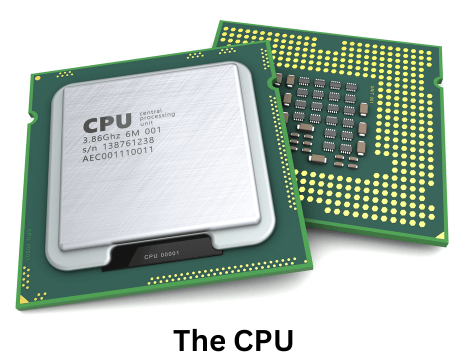Last updated on February 24th, 2025 at 08:23 pm

Are you wondering what the CPU is? Novice users often misuse this term, which can lead to confusion, as some people confuse the CPU with the system unit. In this article, we will clarify this and more.
Keep reading to learn:
- What the central processing unit is;
- The location of the CPU;
- The parts of the CPU;
- The functions of the CPU in the computer; and
- What component serves as a bridge between the CPU and the RAM.
What is the CPU?
The central processing unit (CPU) is the brain of the computer. It processes all of the instructions entered into the computer according to your requirements.

Where is the CPU located?
The central processing unit is located on the computer’s motherboard. On desktop computers that are not all-in-one systems, the motherboard is located in the system unit.
Now that you know where the CPU is located, let’s look at its components.
Parts of the CPU
The central processing unit has two main components:
- The arithmetic and logic unit (ALU) and
- The control unit (CU).

What does the CPU do in the computer?
The central processing unit executes the instructions it receives from the computer’s hardware and software components. This includes the instructions you send when you wish to crop a photo, play a game, or perform calculations.
It does this using the fetch, decode, and execute cycle.
The central processing unit collects the information entered into the RAM (fetch), figures out what the user or program wants to do (decode), and performs the tasks in the instructions (execute). Using the data bus, the results are returned to the RAM (store). The RAM displays this information on the monitor.
⚠️Random access memory (RAM) is the main memory in the computer. It is where all information and programs are stored while they are being used. RAM is volatile, so when the computer is turned off, any information contained in RAM is lost.
What does the CU do?
The CU (control unit) controls the flow of data within the computer system. It controls the interaction between different parts of the computer system.
What does the ALU do?
The arithmetic and logic unit is the part of the computer’s brain responsible for processing all mathematical and logic operations. It performs addition, subtraction, multiplication, and division when requested.
The logical operations performed by the ALU include AND, OR, NOT, and NOR.
How does the CPU communicate with the other components in the computer?
Have you ever wondered how the other components communicate with the CPU? The CPU does not understand information the way you type it on the computer. So, let’s look at what the communication between the RAM and the CPU looks like.
Interaction between the CPU and the RAM
When you work on the computer, any program you open is first loaded into RAM. The data you enter is also stored in RAM.
Imagine that you wish to perform addition on a few columns of data in the spreadsheet. You type your formula. RAM (random access memory) makes it possible for you to do all of this.
Once you’ve finished working, you press enter. The central processing unit collects this instruction from RAM and figures out what you are instructing the computer to do.
It carries out the request and returns the result to the RAM.
Which component stores data being processed by the CPU in the computer?
The RAM (random access memory) and the cache store data that is being processed by the computer’s central processing unit.
When you enter data, it is always stored in the RAM. This is the data on which the central processing unit operates. However, because it takes time to access this information from the RAM, a small amount of it is moved to the CPU cache for faster processing.
What serves as the bridge between the RAM and the CPU?
The system bus serves as a physical bridge or connectivity between the RAM and the CPU, allowing these two components to communicate with each other.
When the CPU performs the work described in the commands, what is this stage known as?
Execute. During the execution stage of a machine cycle, the central processing unit carries out the instructions it receives.
 Skip to content
Skip to content 